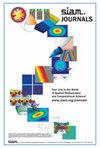Stable Local-Smooth Principal Component Pursuit
IF 2.3
3区 数学
Q3 COMPUTER SCIENCE, ARTIFICIAL INTELLIGENCE
引用次数: 0
Abstract
SIAM Journal on Imaging Sciences, Volume 17, Issue 2, Page 1182-1205, June 2024.Abstract.Recently, the CTV-RPCA model proposed the first recoverable theory for separating low-rank and local-smooth matrices and sparse matrices based on the correlated total variation (CTV) regularizer. However, the CTV-RPCA model ignores the influence of noise, which makes the model unable to effectively extract low-rank and local-smooth principal components under noisy circumstances. To alleviate this issue, this article extends the CTV-RPCA model by considering the influence of noise and proposes two robust models with parameter adaptive adjustment, i.e., Stable Principal Component Pursuit based on CTV (CTV-SPCP) and Square Root Principal Component Pursuit based on CTV (CTV-[math]). Furthermore, we present a statistical recoverable error bound for the proposed models, which allows us to know the relationship between the solution of the proposed models and the ground-truth. It is worth mentioning that, in the absence of noise, our theory degenerates back to the exact recoverable theory of the CTV-RPCA model. Finally, we develop the effective algorithms with the strict convergence guarantees. Extensive experiments adequately validate the theoretical assertions and also demonstrate the superiority of the proposed models over many state-of-the-art methods on various typical applications, including video foreground extraction, multispectral image denoising, and hyperspectral image denoising. The source code is released at https://github.com/andrew-pengjj/CTV-SPCP.
稳定的局部平滑主成分搜索
SIAM 影像科学期刊》第 17 卷第 2 期第 1182-1205 页,2024 年 6 月。 摘要.最近,CTV-RPCA 模型首次提出了基于相关总变异(CTV)正则的低秩局部光滑矩阵和稀疏矩阵分离的可恢复理论。然而,CTV-RPCA 模型忽略了噪声的影响,这使得该模型无法在噪声环境下有效提取低秩和局部光滑主成分。为了缓解这一问题,本文在考虑噪声影响的基础上对 CTV-RPCA 模型进行了扩展,并提出了两种具有参数自适应调整功能的鲁棒模型,即基于 CTV 的稳定主成分搜索模型(CTV-SPCP)和基于 CTV 的平方根主成分搜索模型(CTV-[math])。此外,我们还提出了建议模型的统计可恢复误差约束,这使我们能够了解建议模型的解与地面实况之间的关系。值得一提的是,在没有噪声的情况下,我们的理论会退化回 CTV-RPCA 模型的精确可恢复理论。最后,我们开发了具有严格收敛性保证的有效算法。广泛的实验充分验证了理论论断,也证明了所提出的模型在视频前景提取、多光谱图像去噪和高光谱图像去噪等各种典型应用中优于许多最先进的方法。源代码发布于 https://github.com/andrew-pengjj/CTV-SPCP。
本文章由计算机程序翻译,如有差异,请以英文原文为准。
求助全文
约1分钟内获得全文
求助全文
来源期刊

SIAM Journal on Imaging Sciences
COMPUTER SCIENCE, ARTIFICIAL INTELLIGENCE-COMPUTER SCIENCE, SOFTWARE ENGINEERING
CiteScore
3.80
自引率
4.80%
发文量
58
审稿时长
>12 weeks
期刊介绍:
SIAM Journal on Imaging Sciences (SIIMS) covers all areas of imaging sciences, broadly interpreted. It includes image formation, image processing, image analysis, image interpretation and understanding, imaging-related machine learning, and inverse problems in imaging; leading to applications to diverse areas in science, medicine, engineering, and other fields. The journal’s scope is meant to be broad enough to include areas now organized under the terms image processing, image analysis, computer graphics, computer vision, visual machine learning, and visualization. Formal approaches, at the level of mathematics and/or computations, as well as state-of-the-art practical results, are expected from manuscripts published in SIIMS. SIIMS is mathematically and computationally based, and offers a unique forum to highlight the commonality of methodology, models, and algorithms among diverse application areas of imaging sciences. SIIMS provides a broad authoritative source for fundamental results in imaging sciences, with a unique combination of mathematics and applications.
SIIMS covers a broad range of areas, including but not limited to image formation, image processing, image analysis, computer graphics, computer vision, visualization, image understanding, pattern analysis, machine intelligence, remote sensing, geoscience, signal processing, medical and biomedical imaging, and seismic imaging. The fundamental mathematical theories addressing imaging problems covered by SIIMS include, but are not limited to, harmonic analysis, partial differential equations, differential geometry, numerical analysis, information theory, learning, optimization, statistics, and probability. Research papers that innovate both in the fundamentals and in the applications are especially welcome. SIIMS focuses on conceptually new ideas, methods, and fundamentals as applied to all aspects of imaging sciences.
 求助内容:
求助内容: 应助结果提醒方式:
应助结果提醒方式:


